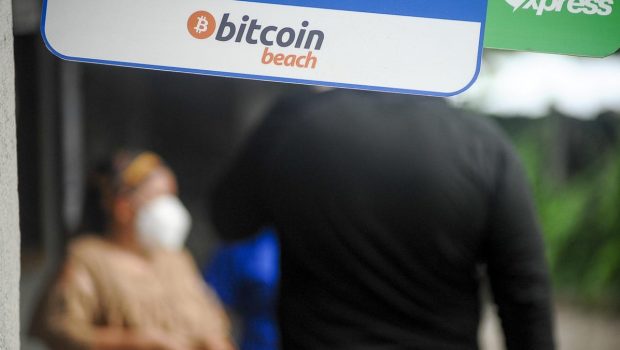New Bitcoin Technology Enables Instant, Global USD Transactions
In 2021, bitcoin the asset (BTC) advanced along its monetization cycle to become established as a global store of value. In 2022, the second stage of monetization is coming into focus—BTC is maturing as a medium of exchange. This is possible through the fundamental stability and security of the Bitcoin blockchain and by virtue of the advancement of the Lightning Network, a second-layer Bitcoin payments technology. The implications are far reaching and include a new potential for financial inclusion for the global unbanked population.
LA LIBERTAD, EL SALVADOR - JUNE 16: A view from a business that accepts bitcoin transaction on June ... [+]
Anadolu Agency via Getty Images
On April 5, 2022, Lightning Labs, a Lightning Network focused infrastructure technology company led by Elizabeth Stark (CE)) and Olaoluwa Osuntokun (CTO), announced the novel ability to issue and transfer assets, including stablecoins such as Tether (USDT), on the Bitcoin blockchain. Issued assets can be transacted on the Lightning Network, and by the end of 2022, Lightning Labs’ Pool product will support liquidity for issued assets in the same way it now does for Bitcoin.
This utility is enabled by a new protocol called Taro, which is designed by Osuntokun. Taro ultimately enables all Lightning Network participants to gain the benefit of Lightning’s nearly free, virtually instant, global transaction capability, without needing to tolerate BTC’s current volatility. BTC’s volatility is now opt-in, even for those using Bitcoin’s Lightning Network, for example, the 3 million Salvadorans reported to have transacted on Lightning in 2021.
The November 2021 activation of Taproot on Bitcoin Core, the latest major update to the Bitcoin protocol, made Taro possible. Taproot increased the Bitcoin blockchain’s security, privacy, and transaction throughput, which also had the consequence of empowering more sophisticated smart contracts on Bitcoin.
Most notably, Taro is a testament to how Bitcoin evolves over time. While protocol development focuses on maintaining and optimizing the core values of the technology for network security and scalability, “conservative” changes can open the design space of what can be built on Bitcoin and Lightning enormously, as demonstrated by Taro’s relationship to Taproot. Importantly - and fundamental to Bitcoin - Bitcoin’s utility is expanded without any change or threat to the promises (aka “rules”) enforced by the software. These rules include the total number of BTC to be put into circulation, the issuance schedule, the compensation schema for miners, and more.
The Use Case for Taro In Emerging Markets
The new protocol will diversify the populations that Lightning Network apps and infrastructure can meaningfully serve. Taro will make Lightning a useful payment rail for populations that have a lower tolerance for BTC’s volatility, including low socioeconomic status populations or those that live paycheck to paycheck.
With this development, BTC volatility can be accessed as deemed appropriate by each user and avoided when losses would be intolerable. In other words, users can turn the dial up or down on their exposure to volatility. Using Lightning and Taro to earn in USDT and/or BTC, for example, a recipient can decide whether to hold funds in BTC for longer term savings or in USDT for immediate or near-term spending. In this way, Taro showcases Bitcoin and Bitcoin’s Lightning Network as both a competitor to SWIFT financial messaging system and to commercial banking.
Lightning Labs writes, “One of our core tenets at Lightning Labs is solving real problems for real people, and we’ve talked to myriad community members in emerging markets who’ve told us what a big difference stablecoins on bitcoin and Lightning would make in their economies.” As the infrastructure => adoption => infrastructure => adoption cycle marches on, the potential of Bitcoin as an open global financial platform can continue to be realized.
Emerging markets, where access to the global economy and financial tools have historically limited, may lead the way.








Gloss